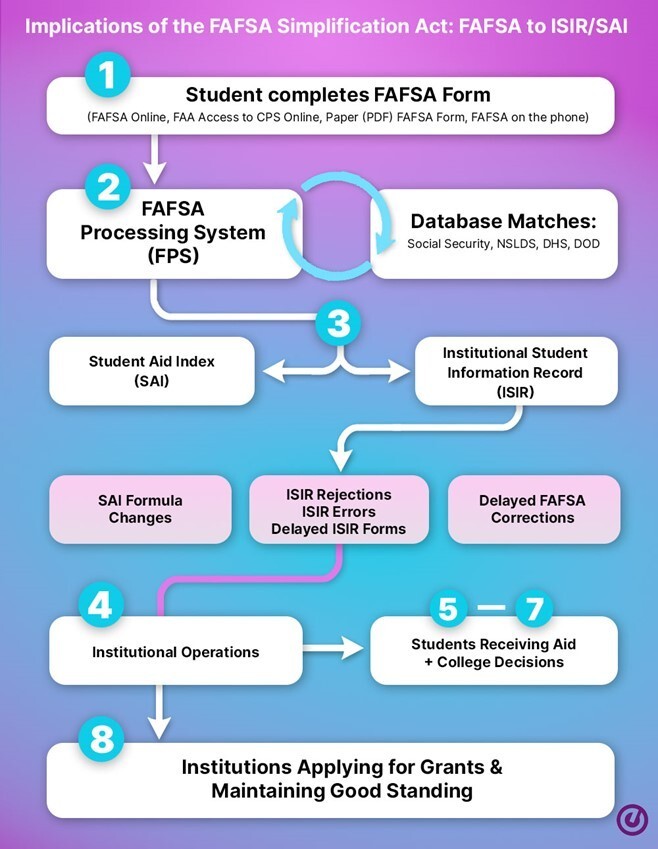As higher education leaders navigate an increasingly complex landscape, the implementation of the FAFSA Simplification Act presents both challenges and opportunities for institutional transformation. Now that the anticipated Act's rollout has been announced, there is an opportunity for institutions to reimagine their approach to financial aid administration and student financial success.

Understanding the Transformation
The FAFSA Simplification Act represents the most significant overhaul of federal financial aid in decades. Beyond simply updating forms, it fundamentally changes how institutions process aid and engage with students throughout their educational journey. As illustrated in the process flow above, the shift from Expected Family Contribution (EFC) to the Student Aid Index (SAI) impacts every stage of the financial aid lifecycle—from initial student engagement through institutional compliance.
ISIR Processing in the New FAFSA Era
The transition to the simplified FAFSA brings significant changes to ISIR processing, a critical component of financial aid administration. Institutions must now adapt to new ISIR data elements and processing timelines, which directly impact aid packaging and disbursement schedules.
Key ISIR Changes to Consider:
- New data elements reflecting the Student Aid Index (SAI) calculation
- Modified handling of multiple ISIR transactions
- Updated verification selection criteria and documentation requirements
- Enhanced direct admissions indicators
- Revised needs analysis methodology
These changes require institutions to:
- Update their systems to process new ISIR data formats
- Modify existing workflows to accommodate revised processing timelines
- Train staff on new ISIR review procedures
- Implement enhanced verification tracking
- Develop contingency plans for processing delays
With the Department of Education's phased ISIR delivery approach in 2024, institutions must be particularly vigilant in managing their processing workflows to ensure timely aid packaging despite compressed timeframes.
Strategic Implications for Institutional Leaders
The modernization of financial aid processes presents several key considerations for institutional leadership:
Enrollment and Retention Impact
Research shows students overestimate college costs by 2-3x the actual amount, creating a significant barrier to enrollment. This perception gap, combined with complex financial aid processes, particularly affects low-income students, with nearly half choosing not to enroll due to confusion about the financial aid process. In today's competitive landscape, institutions cannot afford to lose qualified candidates due to financial uncertainty.
Operational Efficiency
Financial aid offices are increasingly caught between rising student expectations for immediate service and growing administrative complexity. Manual processes and outdated systems not only burden staff but also create compliance risks and delay aid distribution—directly impacting enrollment yields and student satisfaction. The shift in ISIR processing and delivery schedules requires institutions to reimagine their workflows. Financial aid offices must now process higher volumes of ISIRs in shorter timeframes while maintaining accuracy and compliance standards.
Time-Sensitive Processing Requirements
The new FAFSA timeline introduces critical ISIR processing challenges. With the Department of Education's phased ISIR delivery approach, institutions face compressed timeframes for processing aid packages, particularly impacting early decision and regular decision admissions cycles.
Risk Management and Compliance
With the new SAI calculations and modified verification requirements, institutions face evolved compliance challenges. The stakes are particularly high for institutions relying on Title V and Title III grants, where accurate and timely FAFSA processing directly affects institutional funding.
The Path Forward: Technology-Enabled Student Financial Success
Forward-thinking institutions are leveraging modern technology solutions to transform these challenges into opportunities for enhanced student service and institutional efficiency. Key components of a modern financial aid strategy include:
Early Engagement and Cost Transparency
- Implement precise recruitment targeting as early as 9th grade
- Provide personalized net price calculators that deliver accurate cost estimates
- Engage prospective students with clear, accessible financial information
Streamlined Processing and Communication
- Deploy AI-powered solutions for 24/7 student support
- Automate workflow processes with vetted templates
- Utilize dynamic communication tools for personalized offer letters and notifications
Automated ISIR Processing and Management
- Implement real-time ISIR processing capabilities
- Deploy automated verification selection tools
- Utilize intelligent document collection systems
- Enable proactive ISIR correction workflows
- Monitor and track ISIR processing metrics
Enhanced Funding Access
- Implement intelligent scholarship matching systems
- Streamline Title IV reconciliation processes
- Leverage data analytics for optimal aid distribution
Measuring Success
Institutions that successfully modernize their financial aid operations typically see:
- Increased enrollment yield through faster aid package delivery
- Improved student satisfaction and reduced support calls
- Higher scholarship utilization rates
- Reduced administrative burden on staff
- Enhanced compliance and audit readiness
- Reduced ISIR processing time
- Decreased verification processing delays
- Improved accuracy in aid packaging
Looking Ahead
The FAFSA Simplification Act's implementation challenges highlight the need for institutions to build more resilient and student-centric financial aid operations. Success requires more than just technical solutions—it demands a strategic approach that aligns technology, processes, and people around the goal of student financial success.
As we move forward, institutions that embrace this opportunity to modernize their financial aid operations will be better positioned to:
- Meet evolving student expectations
- Optimize operational efficiency
- Maintain competitive advantage
- Support strategic enrollment goals
- Ensure long-term institutional sustainability
- Optimize ISIR processing workflows for future aid cycles
Learn more about how Ellucian's Student Financial Success solutions can help your institution navigate this transformation.




